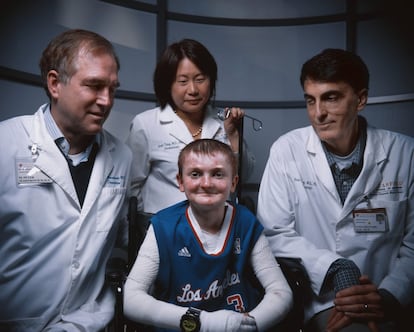Trials of new gene therapy cure ‘butterfly children’ of open wounds that had not healed for years
An experimental treatment created by researchers at Stanford University uses an engineered herpes virus to start production of the missing collagen VII protein, which stops the epidermis and dermis from separating

A gene therapy applied directly to the skin has cured nine patients who were suffering from a rare disease that causes blistering, wounding and scarring as a result of even the lightest contact. Some lesions can remain open for years without closing.
Epidermolysis bullosa is a combination of genetic disorders that cause this hypersensitivity of the skin. The nine patients treated in the trial – three of whom were children or teenagers – suffered one of the most serious forms of the condition. A defect in the COL7A1 gene means that these people were unable to synthesize the collagen VII protein, which keeps together the two outermost layers of the skin: the epidermis and the dermis. The result is that even the mildest touch can cause sores and lesions over the entire body. This includes the mucous membranes that cover the mouth and the digestive tract. These patients have been nicknamed “butterfly children,” given that the disease starts to develop from birth and leaves the skin as delicate as the wings of the insect.
This trial, which was led by researchers at Stanford University in the United States, used an engineered herpes virus containing two healthy copies of the COL7A1 gene. When the deactivated pathogen enters the cells, they begin to produce the protein that corrects the disease.
The most striking part of this gene therapy is that it is applied directly onto the skin via drops, without even needing contact with the wounds. The results of the trial with the nine patients show that the majority of the sores were cured after the treatment and remained closed for at least three months. The untreated sores, however, healed much less. One of the patients was a 10-year-old girl with a chronic chest wound that had been open for four years. The first application reduced the wound by 70%, and it was completely closed after the second round of treatment.
“This therapy strengthens the skin and breaks the cycle of chronic opening and scarring of wounds in the patients,” explained Peter Marinkovich, a dermatologist at Stanford University and the main author of the study, which was published this week in Nature Medicine.
This is the first time that gene therapy has been used against this disease, and also the first use of this type of therapy directly on the skin, the authors of the research point out. Until now, the most successful experimental treatments were graft transplantations. First, a sample is taken of the patient’s skin and the cells treated to correct the genetic defect. Then the tissue is grown until nearly a square meter of healthy skin has been obtained, and it is then transplanted to the patient.
Side effects
This method was successful for some children, who recovered the capacity for wound healing and began to live a normal life. But it was a complicated procedure, and involved major side effects.
By contrast, this new treatment does not need hospitalization. On the one hand, it has a disadvantage in that it does not permanently correct the genetic defect. But on the other, it can be regularly administered without serious side effects, according to the medical team behind the trial. After the treatment, the researchers took biopsies from the participants’ wounds. The results showed that just a few days after receiving the medication their cells were already producing the collagen VII needed for the wounds to close.
The next step for research will be to apply the treatment to mucous surfaces such as the oropharynx, esophagus or eyes, explain the authors of the study. “In total, the preliminary conclusions and treatment advances described here have far-reaching implications with the potential to broadly transform the gene therapy field,” the authors state. The new treatment will be developed by biotechnology firm Krystal Biotech, which is based in the United States. The team has already begun the last phase of the clinical trials.
Tu suscripción se está usando en otro dispositivo
¿Quieres añadir otro usuario a tu suscripción?
Si continúas leyendo en este dispositivo, no se podrá leer en el otro.
FlechaTu suscripción se está usando en otro dispositivo y solo puedes acceder a EL PAÍS desde un dispositivo a la vez.
Si quieres compartir tu cuenta, cambia tu suscripción a la modalidad Premium, así podrás añadir otro usuario. Cada uno accederá con su propia cuenta de email, lo que os permitirá personalizar vuestra experiencia en EL PAÍS.
¿Tienes una suscripción de empresa? Accede aquí para contratar más cuentas.
En el caso de no saber quién está usando tu cuenta, te recomendamos cambiar tu contraseña aquí.
Si decides continuar compartiendo tu cuenta, este mensaje se mostrará en tu dispositivo y en el de la otra persona que está usando tu cuenta de forma indefinida, afectando a tu experiencia de lectura. Puedes consultar aquí los términos y condiciones de la suscripción digital.
More information
Últimas noticias
Alain Aspect, Nobel laureate in physics: ‘Einstein was so smart that he would have had to recognize quantum entanglement’
Imelda Castro, the woman who wants to rule the cartel battleground of Sinaloa
The new victims of the Republican war on Obamacare: Millions hit by soaring health insurance premiums
A country divided on migrant rights: Some US states expand protections while others restrict them
Most viewed
- David King, chemist: ‘There are scientists studying how to cool the planet; nobody should stop these experiments from happening’
- Reinhard Genzel, Nobel laureate in physics: ‘One-minute videos will never give you the truth’
- Oona Chaplin: ‘I told James Cameron that I was living in a treehouse and starting a permaculture project with a friend’
- Sinaloa Cartel war is taking its toll on Los Chapitos
- Mexico completes its trade shift with the entry into force of tariffs on China and countries without trade agreements











































